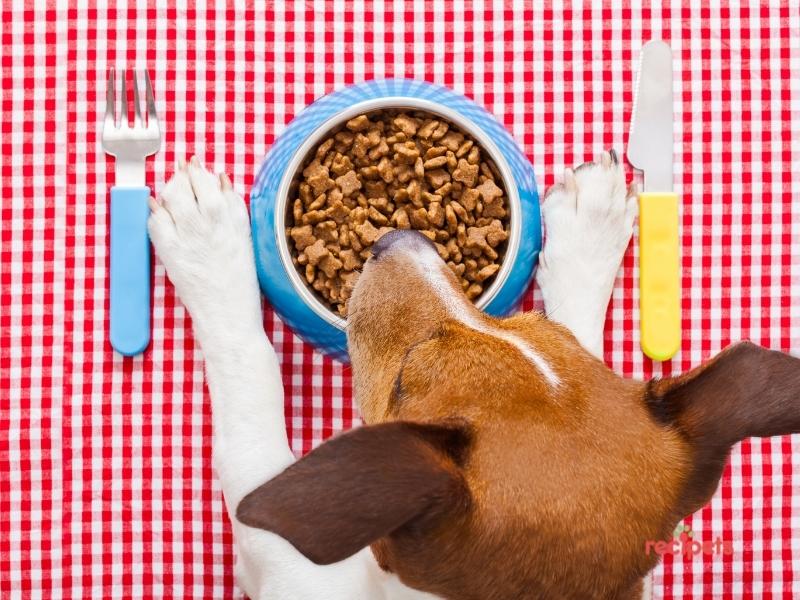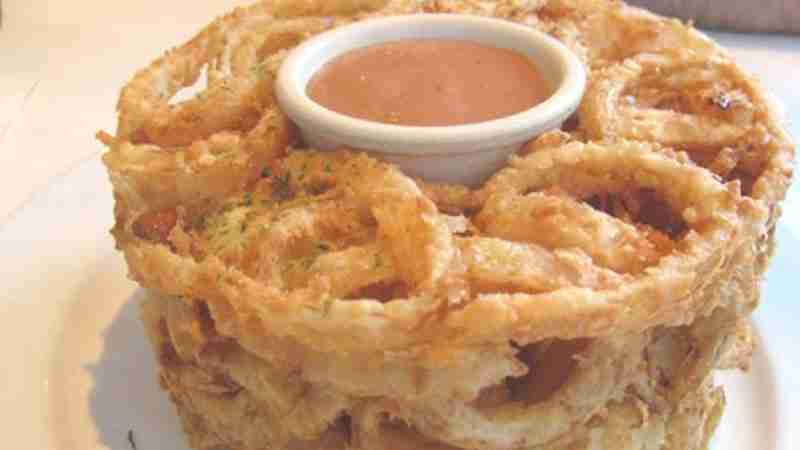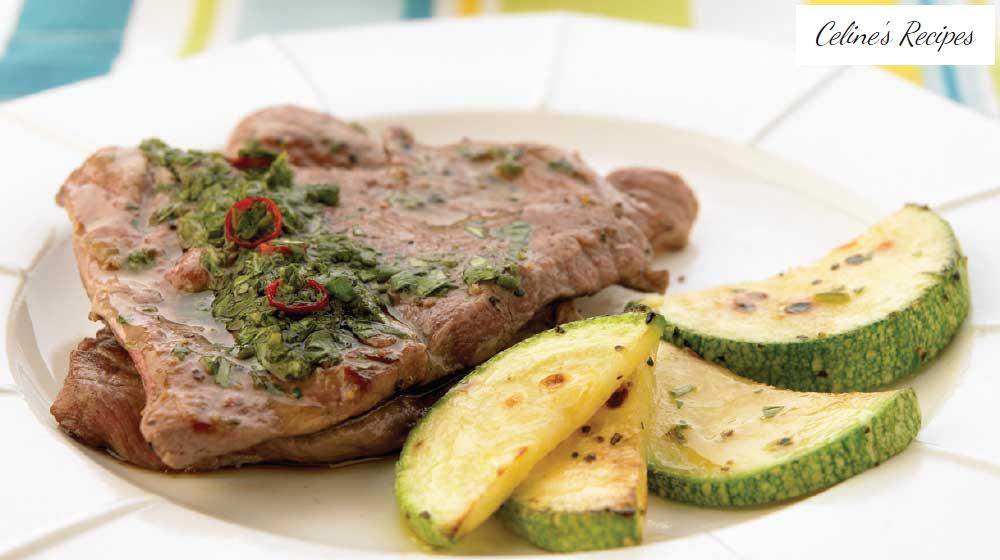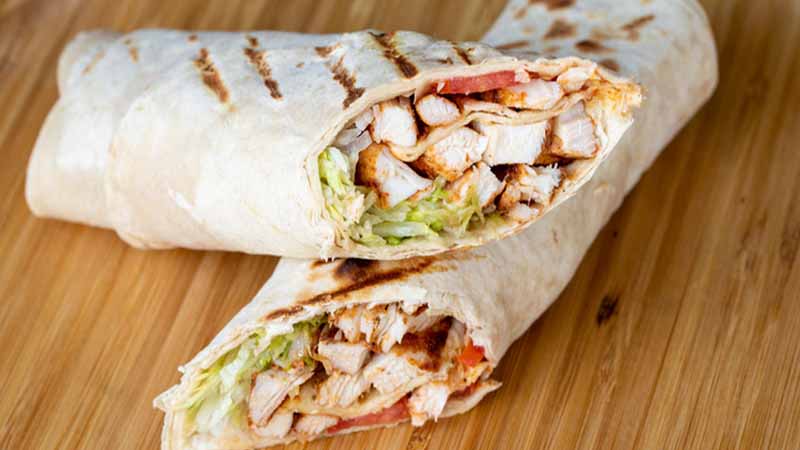[ad_1]
If you have a dog, then there is a high chance that it may be sensitive to certain food. Dogs are prone to allergies and sensitivities in the same way that humans are. If you notice your dog having symptoms of vomiting, diarrhoea or constipation after eating any type of new food, then they might have an intolerance or sensitivity to that food.
Food reactions account for about 10% of all “allergies” that dogs experience and produce a wide range of symptoms. Food allergies are not the most common reason behind your dog’s symptoms — food intolerance (sensitivities) is more likely to be at the core of their suffering giving them a sensitive tum and other symptoms.
Even if you’re giving your dog a healthy diet, something in their diet may start causing a reaction. What was fine to eat a year ago may now cause an issue.
Dog food sensitivities are a fairly common issue, but true allergic reactions to food substances are not. In fact, genuine dog food allergies are quite rare, and the majority of times, a diagnosed dog food allergy is a really a food sensitivity (also known as intolerance). If your pup has a sensitivity to certain foods, it can be difficult to know what they should eat. But don’t worry- in this article we will discuss the symptoms of dog allergies and sensitivities, how to introduce new foods into their diet safely, and what you should do if they have a reaction.

What’s the difference between food allergy and food sensitivity?
Immediate food allergies that cause signs such as hives and trouble breathing are exceedingly rare in dogs. If you believe your dog is suffering from food-induced anaphylaxis, bring them to your nearest vet clinic immediately. Your vet will quiz you on what your pet had been eating, to try and get to the root cause of the reaction. Treatment generally includes oxygen therapy and steroids as well as anti-histamines.
Food sensitivities are more common than food allergies. Signs can include itchy and red skin, chronic yeast infections and runny stool. The top culprits are dairy, chicken, beef, peas, potato and grains. Certain breeds are more prone to food sensitivities, including Frenchies and Labradors. Those dogs with white fur tend to be over-represented.
“The vast majority of dogs will not have food allergies or sensitivities. Those who do react to foods, typically show signs in their first few years of life. Food allergies tend to be over-diagnosed by owners, with many assuming their dog is allergic to grains or a certain meat, when there is actually another medical issue, such as IBD, going on.” said Dr. Linda Simon, MVB MRCVS, Consulting Veterinarian at FiveBarks.
How to tell if your dog is allergic or sensitive to a food substance
Dr. Megan Conrad at HelloRalphie, a virtual veterinary care provider, offers this advice:
Allergies can range from anaphylactic shock (uncommon) to gastrointestinal upset (GI) to skin reactions like itching and hives). If your dog shows any signs of an immediate reaction, such as facial swelling, hives, vomiting, drooling, or any difficulty breathing, contact your vet right away. The most common sign of food allergy is itching that’s continuous, rather than seasonal or GI upset such as vomiting or diarrhea.
Your dog may be scratching, licking, or biting at their skin, sometimes all over, other times in specific body areas such at the face, ears, and feet. An allergic reaction to food doesn’t necessarily happen with new food, it can develop over time with something your dog’s eaten for years (just to make things more confusing)!
Since many other conditions can cause skin irritation and itching, it’s important to rule out fleas, mange, bacterial or fungal skin infections, and environmental allergies (called atopic dermatitis).
9 Signs that your dog may be sensitive to a food substance
- Red, itchy, inflamed ears, frequent head shaking
- Hair loss
- Hives, skin rash, or inflamed skin
- Open sores or hot spots
- Coughing, wheezing, shortness of breath
- Runny, red, or itchy eyes
- Runny or stuffy nose, sneezing
- Odor from feet or ears (due to secondary bacterial or yeast infections)
- Stomach upset, gas, vomiting, diarrhea
If these conditions aren’t present, or your pup’s itching doesn’t resolve with treatment for any of them, a food allergy is more likely. This goes for food allergies that present as GI signs.
Your vet may want to run a blood panel, check a fecal sample for parasites or discuss imaging of your pet’s GI tract depending on their symptoms. Your vet may then recommend a food trial, where your dog is fed a special diet with limited ingredients.
The important thing to keep in mind about a food trial is that the recommended food is all your dog is allowed to eat-no treats or other food, and it can take weeks to determine results.
Dr Wigfall suggests you look for these signs to differentiate between food and environmental allergies
- The itching is not seasonal, it occurs all year round not just in the summer months
- The Itching started when the puppy was less than 6 months of age
- Corticosteroids have not been helpful in managing the itching. (Corticosteroids may or may not work on food allergy itching are commonly effective for other allergies)
- There are accompanying intestinal signs like vomiting or diarrhea (approximately 30% of cases will also have a gastrointestinal component)
- The itching and skin areas affected include: Axillae (behind the dogs forelimb), abdomen, inguinal (inner thighs) , perineum (around the gentials/tail base) , face, feet and ears.
What causes food allergies in dogs?
Dr Corinne Wigfall, BVMBVS(Hons) BVMedSci(Hons), at Spirit Dog Training said, “Food allergies are caused by an immune response triggered after the food protein has been metabolized, and the body acts as if it is a foreign invader. The inflammation targets the gastrointestinal tract, and most commonly in dogs, their skin. This results in severe pruritis (itching) and sometimes is the gastrointestinal tract is affected, vomiting and diarrhea.
Generally, food hypersensitivities occur over a chronic duration, but many people assume that itching due to a food allergy requires a recent diet change, but in fact, the opposite is true – sometimes the dog will have been eating the food for years prior to any issues being noted.
Food allergies that cause pruritis can lead to secondary skin infections after the animal has been scratching at themselves which can worsen the problem. However, no one test can diagnose a food allergy. There are many reasons why dogs itch and food allergies are one of many triggers, environmental allergies for example, pollen, can cause very similar skin lesions to food allergies so it can be hard to distinguish between them.
How to diagnose a food allergy
Veterinary consultation is essential to rule out other causes of pruritis, as there are many other more common reasons that can cause itching (e.g, fleas, mites etc). Diagnostic tests will be run to rule out these conditions, such as tape tests, skin scrapes, hair plucks, ear cytology and skin swabs to assess for infection.
Generally, diet changes are needed to prevent the allergic reaction. Elimination diets for six to ten weeks are advised, this involves swapping the diet to one based on a novel protein or hydrolsed proteins, which are easily digested and thus do not result in the immune response triggered by the protein that was in the original diet.
Prescription diets are recommended, e.g. Hills Z/D, as these are balanced and complete, so contain the correct daily nutrients for your dog, however home prepared diets are also used in the elimination diet period using novel proteins and carbohydrates that your dog wouldn’t have been exposed to previously, for example kangaroo and sweet potato. Discuss with your veterinarian a suitable elimination diet for your dogs needs.
Confirmation of food allergy can be seen by rechallenging with one protein source for at least three weeks, for example chicken. This can be repeated for all major protein types using one protein at a time. You can then determine which proteins are associated with the allergic reaction. This is a slow process.
Are food allergy tests for dogs accurate?
Dr. Simon commented “While food allergy tests are available, they are not always reliable and false-positive results are common. This means that certain foods flag up as ‘allergens’ when a dog is actually able to tolerate them without showing any signs. Allergy testing can be done via skin or blood test and can be costly. When a food allergy is suspected and the tests are run, they need to be interpreted with caution by a veterinary professional.”
Common Foods Causing an Allergic or Sensitive Reaction
A food allergy can also be caused by excessive exposure to a particular food. If your dog is reacting to something in their diet, it’s probably the protein content. And not just meat protein; some vegetables contain protein, so they aren’t necessarily safe.
The top offenders are commonly found in dog food:
- Beef
- Dairy Products
- Chicken
- Fish
- Chicken Eggs
Dogs can be allergic to plant-derived components like corn, wheat, soy, and grains; however, they are not as common allergens as many people believe. So a grain-free dog food alone will not cure their issues.
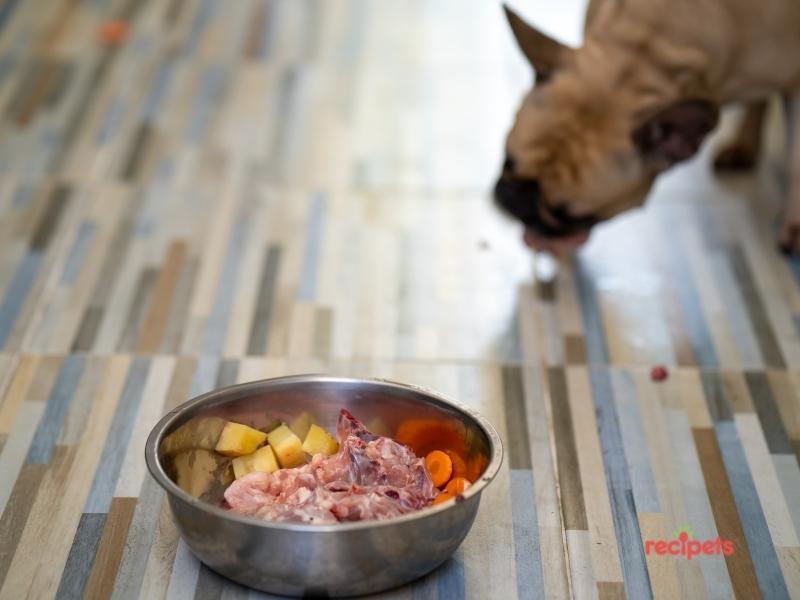
How to introduce new foods to your dog
“Your dog’s diet will change with time, this happens naturally as they age, as food requirements change depending on which life stage they are in, they may also require to change food due to changes in health or activity level. Generally, dogs will need to switch from puppy food, to adult, then later to senior foods, so knowing how to correctly implement a food transition is important to avoid dietary upsets.
New foods need to be introduced gradually, this is the most important factor. Abrupt complete dietary swaps can cause dietary indiscretions, causing gastrointestinal upsets such as vomiting or diarrhoea,” advises Dr Wigfall.
How to transition your dog to a new food
When transitioning from one food to another, it is advised to do this over seven days.
- On days one and two, offer your dog their daily food allowance, but in a ratio of three quarters original diet to one quarter new diet.
- On days three and four, change this to a ratio of 50:50, so half the original diet, and half the new diet.
- On days five and six, change this to three quarters new diet, to one quarter of original diet.
- On days seven onwards, you can offer your dog their daily allowance of just the new diet, as the original diet has been appropriately phased out. “
Important things to note for introducing new foods:
- Puppies should transition to adult food from twelve months of age
- Puppies should swap to a breed specific adult food, e.g. Large breed and small breed.
- From seven years of age onwards, small and medium breed dogs should transition to senior or mature adult food
- Large breed dogs should transition to mature or senior adult food from the age of five.
- Nursing or pregnant dogs should transition to puppy food to offer higher energy dense food
- If the health status of your dog changes and your veterinarian has advised a diet swap then switching to prescription diet may be necessary (for example, weight management diet, diabetic diet, hypoallergenic diets, mobility diet, dental diets, liver or renal diets etc)
Sometimes the new food introduced may not agree with your dog, even if appropriate transitioning of the diet has been followed some animals may develop health complaints in response to a change in diet.
If you notice your dog refusing to eat the new food, or develops vomiting, diarrhoea or constipation, then slow the rate of transitioning of the new food. If the signs persist, then consulting a veterinarian is advised.
Dr. Conrad added, “Always consult your vet before changing your dog’s food. Because many pet owners care as much about their pet’s diet as they do their own, many fad diets make it over to the dog food aisle but not all of them are beneficial – or even safe. Many people think they are doing right by their dogs by buying gluten-free or grain-free diets, only to find that grain-free diets are linked to heart disease!
If you are interested in putting your dog on an alternative diet such as raw food, meat-free, etc., be sure to talk with your vet about the benefits and dangers before making the switch. They may also refer you to a veterinary nutritionist if you want to make your own food for your dog.
“Owners do not need to introduce ingredients in a particular way to their pet. They should simply offer a high quality, nutritionally balanced food that is suitable for a dog’s life stage. Of course, with any diet introduction it is important to monitor dogs closely for signs such as vomiting, diarrhoea or bloating.” recommends Dr. Simon.
What can you do to help your dog with food allergies and sensitivities?
It can be very useful to trial a hypoallergenic, hydrolysed diet when a food sensitivity or allergy is suspected. The protein particles are broken up so the body does not recognise them as foreign and will not react to them. Examples of these diets include Hills z/d and Royal Canin Anallergenic.
Owners must avoid giving all other foods, treats, scraps and chews for 8 weeks. It can take several weeks for improvements to occur and signs to improve when on a hydrolysed. If a dog has a pre-existing skin disease or infection, this must be managed medically first. If the diet works, we can then ‘challenge’ the dog by giving them their old diet to see if symptoms recur.

Dog Food Allergy FAQs
How long after eating does a dog food allergic reaction happen?
Dog food allergies are typically triggered within minutes of eating the offending food. For dog with an IgE-mediated allergy, some reactions can be life-threatening. Other types of allergic reaction to dog food may not involve the immune system and can take months before symptoms are seen, these are usually caused by proteins in foods which cause irritation or inflammation of the digestive tract lining.
Can dog food allergies cause coughing?
Yes, coughing is a common symptom of dog food allergies. Coughing can be caused by a number of different things, including allergens in the air, a virus or infection, or even heart disease. If your dog is coughing and you think it might be related to their food, talk to your veterinarian about it. They may want to do some tests to see if there is an allergy causing the problem.
How long does it take for a dog food allergy to go away?
Both food allergies and sensitivities can be lifelong conditions for dogs. If you remove the offending food from their diet and they don’t have any other symptoms, then they should be able to live a normal life. However, if your dog starts having reactions again after being off of the food for a while, then it’s likely that they will always have to avoid that particular ingredient.
Can a dog develop an allergy to its food?
Yes, dogs can develop allergies to their food over time. If your dog is always itching or licking, has ear infections, diarrhea, vomiting, hot spots on their skin that never seem to go away or they are losing weight despite being fed the same amount of food as before then it may be an allergy.
Do puppies outgrow food allergies?
No matter what stage of life, when a dog is proven to be reacting to a certain food, you should keep it out of their diet for ever. Food allergies tend to persist for a dog’s life. So, if your dog has been prescribed a certain food, be strict when it comes to their diet.
In conclusion
Dog owners are more aware of the different types of sensitivities that their dogs can have. When a dog is proven to be reacting to a certain food, you should keep it out of their diet. Food allergies tend to persist for a dog’s life. So, if your dog has been prescribed a certain food, try to be strict when it comes to their diet. By being mindful about what goes into your dog’s diet, you will be able to ensure he has a healthy and happy life!
If you’re worried at all, then seek advice from your vet.
Recipes for dogs with sensitive stomachs
Crunchy Carrot and Sweet Potato Dog Biscuits
These Crunchy Carrot and Sweet Potato Dog Biscuits are the perfect way to give your pup a tasty snack that’s also good for them. They’re packed with nutrients like antioxidants, vitamins A and C, protein, fiber and omega-3s. Plus they’re easy to make! Your pup will love these treats because of how delicious they taste as well as all the benefits they provide. You’ll love these biscuits because you know you’re giving your dog something nutritious while also saving money on expensive store bought snacks.
Check out this recipe
Add to CollectionGo to Collections

Best Ever Simple DIY Dried Sweet Potato Dog Treats
Check out this recipe
Add to CollectionGo to Collections

Apple and Banana Dog Cake – Grain Free
If you’re looking for a healthy and delicious treat for your dog, these Apple and Banana Dog Cakes might be just what you’re looking for! You can either make little pupcakes out of the mix or bake a larger cake for your dog’s birthday. The cakes can also be frosted with your choice of frosting – mashed potator, peanut butter or whipped cream cheese!
Check out this recipe
Add to CollectionGo to Collections

Oven Dried Banana Dental Chews for Dogs
Check out this recipe
Add to CollectionGo to Collections

2 Ingredient Banana Biscuit Treats
Check out this recipe
Add to CollectionGo to Collections

[ad_2]
Source link

